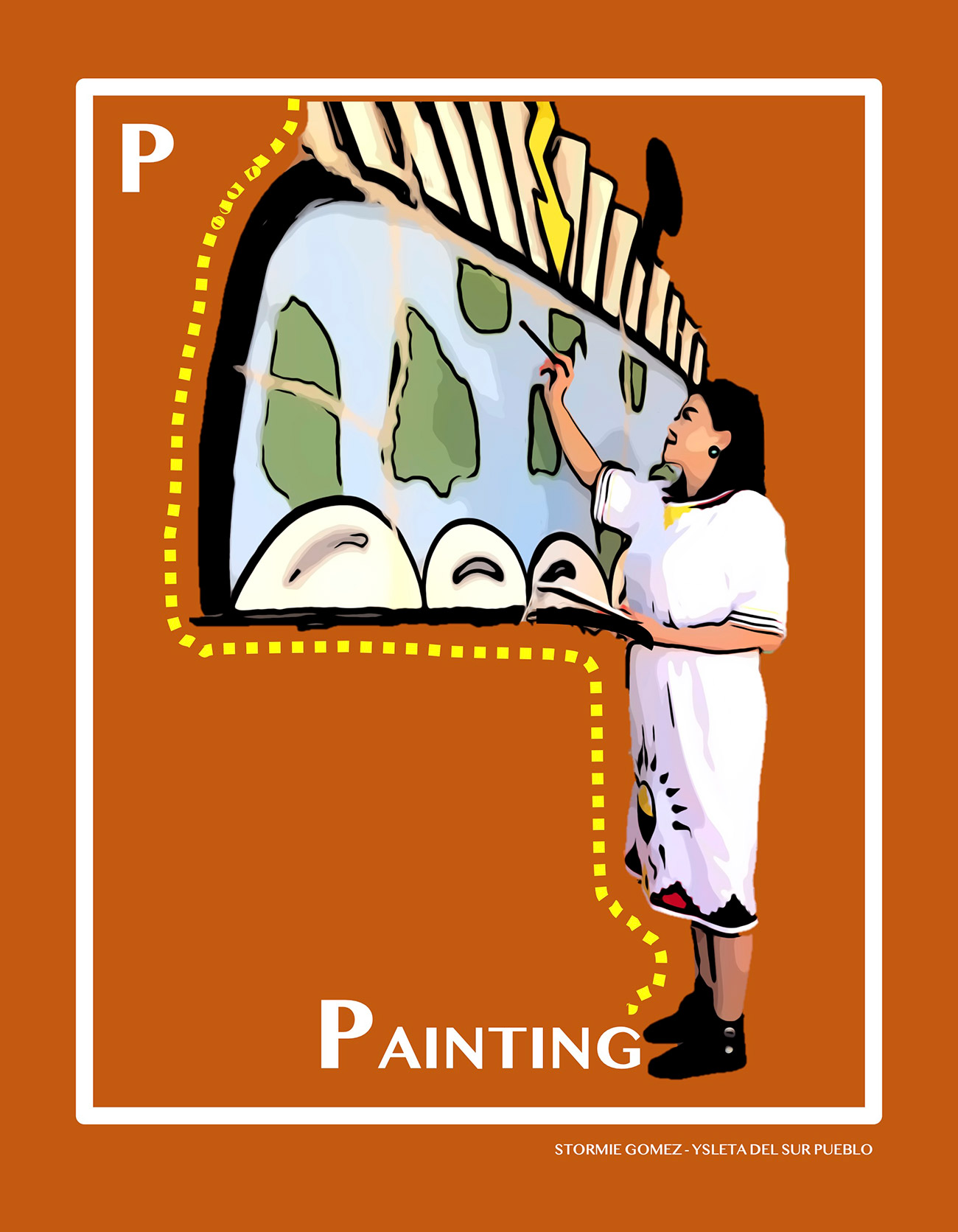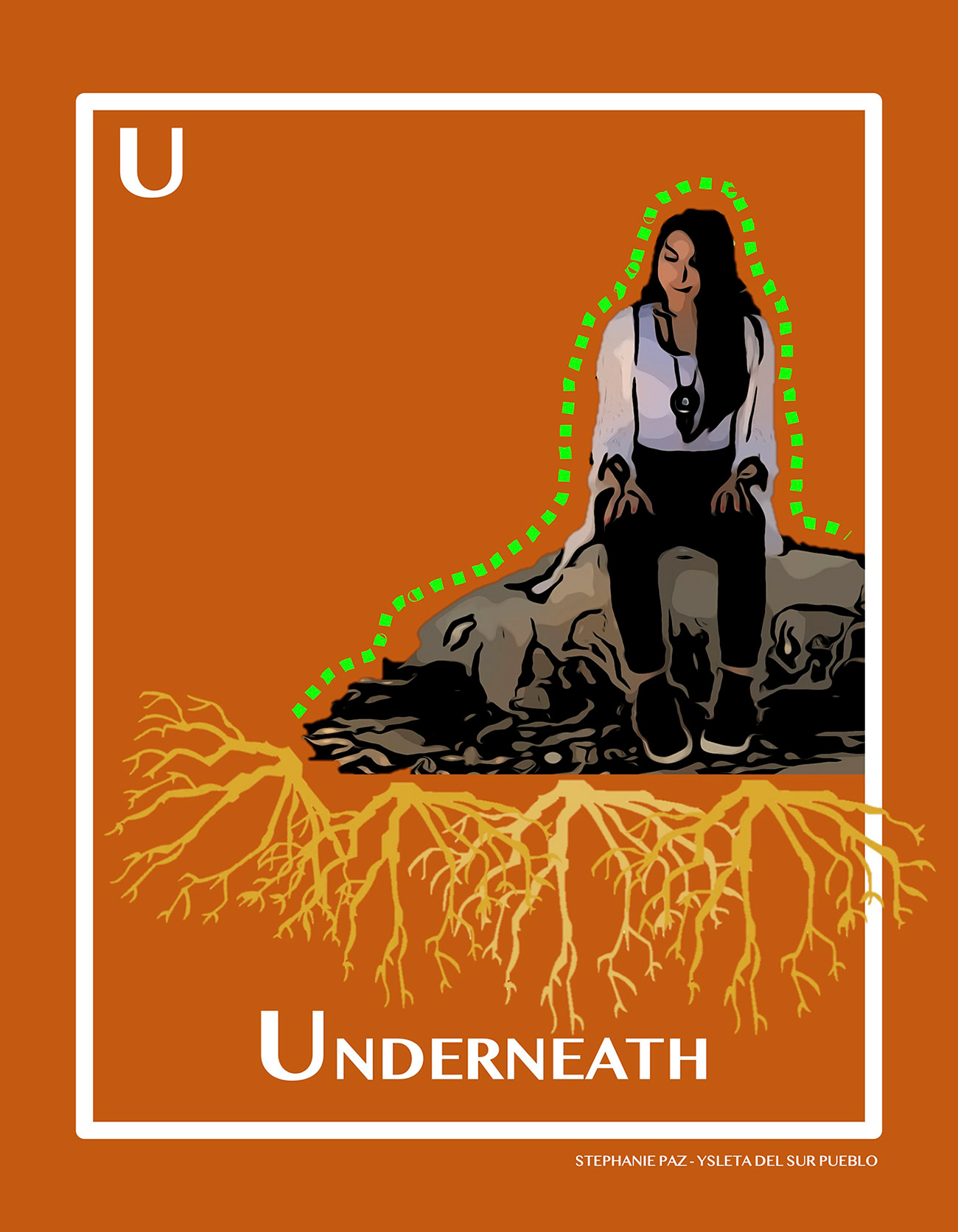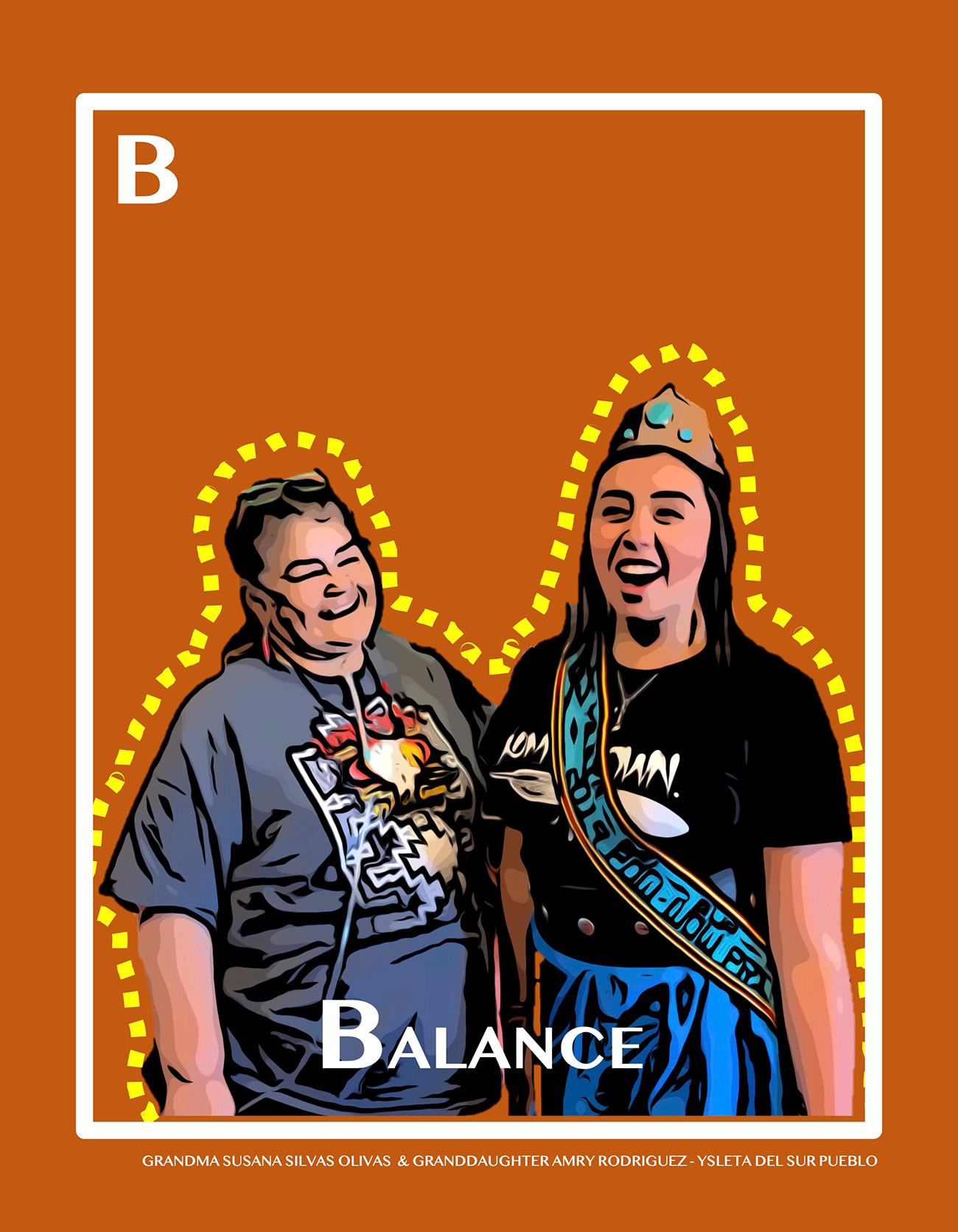Lower Rio Grande, New Mexico
PUEBLO Analysis: An Indigenous Planning Tool for Ysleta del Sur Pueblo
The practice of indigenous planning is predicated on adhering to land-tenure traditions and upholding the unique cultural worldviews of indigenous communities” (Indigenous Planning Mission Statement).1Jojola, Ted. “Indigenous Planning—An Emerging Context.” Canadian Journal of Urban Research 17, no. 1 (2008): 37-47. In 1975, the Indian Self-Determination Act gave rights to federally recognized tribes to contract their own education, health, social, and economic development services. This returned to tribal societies the previously usurped authority to actively plan their communities.
This feature by Theodore Jojola and Saray Argumedo of the University of New Mexico explores the intersectionality of hegemonic oppression that Western mainstream community development and planning practice imposes on Indigenous people. Specifically, it assesses the relevance of a standard participatory tool called the SWOT Analysis and contrasts it with new emerging tools that serve to decolonize participatory methodologies. These new Indigenous planning methodologies are designed to be inclusive and culturally relevant, and have been developed with the participation of Indigenous communities in Chiapas, Mexico, and Ysleta del Sur in El Paso, Texas. Repurposed as BARRIO and PUEBLO Analyses, these methods have been applied and refined to attune Indigenous communities to adaptive tools that combine Westernized-Eurocentric education and research methodologies to practices informed by traditional knowledge. —Ane González Lara, Diverse Peoples, Arid Landscapes, and the Built Environment report editor
Foreword
The PUEBLO Analysis is an example of how Indigenous nations like Ysleta del Sur Pueblo (YDSP) control their communities, narrative, self-governance, and futures. To be Pueblo is to respect the “sacred gifts” of the ancestors; to reflect on who we are as a sovereign nation and how we will reclaim all that lays dormant; to assess our present state; and to plan in a manner that provides instruction for the Tigua2 Tigua is both a cultural and a language designation. YDSP is one of 20 Indian Reservations that belong to the Pueblo nation, five of which speak Tigua. yet to be born. To prepare for the upcoming or “seven generations” is to listen to the ancestors’ original instructions so we may guide our youth to be grounded in the Pueblo lifeways.
It is not by chance that we remain after being dispossessed of land, denied from practicing culture and language, and experiencing systemic oppression. Resilience, devotion, and strategy have aided YDSP to build, rebuild, reconstitute community, and endure. We must call upon our Indigenous wisdom so as to release ourselves from colonial conceptions and trauma so that we may resurge in full force.
The PUEBLO Analysis regards traditional Pueblo values and paradigms and considers strategies and capacity-building to navigate contemporary issues. The analysis acknowledges that participatory engagement is deep-seated upon Pueblo governance and seeks to garner expertise from within the community by engaging elders, leaders, traditionalists, and citizens.
Moreover, it supports the youths’ ability to contribute and be vested in their future. As an internal tool, it guides Tigua youth to garner from foundational Pueblo ways of knowing. The PUEBLO analogy connects the vital Pueblo values of Painting, Underneath, East, Balance, Love, and Offerings. As a Pueblo model, it reminds us that we must:
- Consider our beauty as Pueblo people,
- Be rooted in a Pueblo way of life,
- Call upon natural elements of the earth, sun, and water that support life,
- Recall the creation stories,
- Define for ourselves what nationhood and self-governance looks like at YDSP,
- Appreciate and care for one another,
- Recognize the gifts of the grandfathers, and
- Reciprocate by offering oneself.
The Analysis cleverly integrates strategic principles of community engagement, data collection, and planning into the assessment of programmatic outcomes and impacts. As an analysis model, it fosters programmatic transparency and accountability. By redesigning the framework of the Strengths, Weaknesses, Opportunities, and Threats (SWOT) Analysis, the PUEBLO Analysis supports culturally appropriate strategic orientation in a manner that instills Pueblo-determined positive action. What is more, design contributions are driven by up–and–coming Indigenous and young Tigua leadership.
The PUEBLO Analysis recognizes that Tigua systems of governance and programs that provide for the people must breathe life into community. It empowers the Pueblo’s youth so that they may gain skillsets to move community forward in a culturally sustained and economically secure manner. The ancestors have sent their blessings. We must be smart and strategic, but also listen to our hearts and hear their whispers.
They are showing us our PUEBLO way.
—Patricia Riggs, YDSP Citizen and Indigenous Consultant, 2020
PUEBLO Analysis
The PUEBLO Analysis approach was developed and introduced in the fall of 2018 for an evaluation of the BRAVE Program at Ysleta Del Sur Pueblo (YDSP) in El Paso, Texas. The mission of the BRAVE Program, sponsored by the Pueblo’s Department of Tribal Empowerment, is to provide a safe, healthy, and drug-free environment for the Tigua youth at the Pueblo.
The evaluation was conducted to assess the BRAVE program as a whole to better understand:
- the program’s current performance;
- the external communication between program staff and the extended community;
- key elements on how to improve the program from an internal perspective;
- collective implementation of new ideas, framework, and practice; and
- how to ensure culturally appropriate practices.
Traditionally, this process would use the SWOT (Strengths, Weaknesses, Opportunities, Threats) participatory methodology. Developed in the nineteen-sixties at the Stanford Research Institute, SWOT Analysis has been adapted very successfully by community developers and planners for engaging leaders, administrators, and managers in determining strategies for organizational planning. Participants map out and reflect on the four elements of a SWOT matrix to understand the internal and external influences on an organization and its work and mission. The goal is to refine strategies and approaches to overcome weaknesses and improve efficacy.
Unfortunately for communities like YDSP, the technique tends to come across as vague and esoteric. Unlike mainstream urban communities, the Pueblo is semi-rural and is in a place where essentially everyone shares a common land base, sustained histories of engagement, and kinship relationships to one another. In such communities, dialogue and storytelling is particularly valued. Moreover, this narrative approach is enriched by staging conversations across intergenerational voices.
Ysleta del Sur Pueblo has a remarkable history of resilience. It was founded after the 1680 Pueblo Revolt in the region known as the Paso del Norte. It was settled by Tiwa natives and remnants of the Tompiro and Piro peoples who had been displaced when Spanish colonialists were evicted from the region. The natives continued to practice their agricultural subsistence lifestyle and, over the centuries, endured Spanish Colonial and Mexican rule. With the advent of Texas statehood in 1845 and the Treaty of Guadalupe Hidalgo in 1848, the Anglo-American era was ushered in.
The Tigua people
The Tigua people from Ysleta del Sur Pueblo migrated during the 1680 Pueblo Revolt from Isleta Pueblo alongside Spanish colonialists who fled the Pueblo territories they once occupied. Their migration route was along the southern reaches of the Rio Grande. Both the village of Ysleta del Sur and the City of El Paso were founded at this time. The route they traversed, called the Camino Real, linked them to the Audencia, the high court located in Mexico City. Ysleta still maintains its cultural affiliation with the Pueblo Nations of New Mexico, and their government is the twentieth and newest member of the All Pueblo Council of Governors. It is only by historical accident that they occupy lands in the state of Texas, although they identify culturally with historic sites that are abandoned in what is now the Salinas Pueblo Missions National Monument in New Mexico. Today, they are one of three federally recognized American Indian tribes in the state of Texas.
Although the new Texas Legislature formally recognized the Ysleta Land Grant deed of 1751, much of the fertile valley of their settlement was lost to unscrupulous land speculators. Nonetheless, they continued their distinct Pueblo traditions by maintaining close ties to their ancestral homelands. Over time, they gradually cross-assimilated with nearby Mexican and Spanish settlements adjacent to the Rio Grande. As their historical land base became depleted, the remaining families and their community began to be referred to as the Barrio de los Indios.3Houser, 1970 In 1958, what remained of their traditional lands was annexed by the City of El Paso. Efforts to thwart city taxes promulgated their attempts to protect their community by obtaining legal status as American Indians. These petitions resulted in the 60th Session of the Texas Legislature recognizing them as an Indian community in 1967.4Comar, pg. 332 Unfortunately, the victory was short lived. In 1968, they lost their United States Federal Indian status when they were subjected to the Indian Termination Act (Public Law 90–287 82). It was not until 1987 that their federal status was restored. By this time, only 69 acres of the original Spanish Land Grant of 36 square miles remained.5Houser, 1979, pg 141 The holdings were not contiguous, further compounding tribal jurisdictional challenges over an area that did not resemble an Indian reservation. Moreover, the enabling legislation subjected them to Texas statutes (Public Law 100-89). Texas law prohibited gaming operations, and this severely curtailed the tribe’s ability to generate local income through Indian gaming. In spite of this, the restoration of their federal status resulted in a cultural renaissance. They used their ancestral past to infuse the development of tribal programs in housing, economic development, and education that reflected their Pueblo Indian community identity.
PUEBLO Analysis is a response to this effort. It is a coping technique for building community consensus around Pueblo values. As a process tool, it has the same goals as the SWOT Analysis. However, unlike the SWOT Analysis, it is adapted to opening up a dialogue that encourages self-reflection, interactive intergenerational participation, and cultural assessment.
Much like SWOT, PUEBLO is an acronym that associates key elements with cultural concepts. It is informed by traditional knowledge and invokes other sensory dimensions to build the discussion. The matrix is ordered in the following manner, and is informed by the corresponding cultural values:
The act of painting provokes a narrative that is innate among visual learners. The cliché that “a picture is worth a thousand words” is very much evidenced in the cultural symbols, drawings, and representations that are depicted in daily Pueblo life. There is a reason that many Pueblo people are world-renowned artisans. This visual sensibility is represented in the items that they produce on a daily basis, and it has become the mainstay of their formal and informal economies. This element builds on that skill. Art and painting, in particular, gives representation.
The Tigua people believe that the origin of the human world is the earth. Millenia ago, it was the koshare, or sacred clown, who used his corn tassles to open a crack that leads to the surface of the earth that the Pueblo community now occupies. Upon their emergence, the Pueblo ancestors embarked upon a migration to the four corners of the world, where they learned from the earth and other civilizations. They continued their journey until they found the ordained center-place from which they built their village. It is from underneath, as such, that both life and the challenges to become human originated.
East is the most important sacred direction in Pueblo life. The place where the sun rises is where newborn babies are introduced to the ancestors. East is the direction of renewal and marks the beginning of time as it progresses through the cycles of the day, the year, and the generations. It is also the positional marker that orients people directionally (in opposition to the Euro-Western orientation of north). It is the direction in which daily prayers and sacred pollen are offered to the ancestors.
Healthy community is defined as a balance between human and natural resources. Together they represent the building blocks of society. It is the underpinning of resilience and sustainability. Without balance, there is no healthy community. The relationships of people to the land and the earth creates the unique imprint of culture. It is typified by their worldview and the ordering of how individuals sustain themselves in a manner that takes what has been inherited and used in a beneficial manner as passed onto the new generations.
Pueblo communities are matriarchal. When a child is born, they inherit the clan of their mother, who in turn inherited it from her mother. Only women can give birth, and it is the eldest daughter who is destined to become the matriarch of the extended family. The element that gives cohesion to this progress is unconditional love: love of the child, love of the people, love of life. This emotion transcends all aspects of society and its organizations.
Pueblo people are collective. Individualism is subsumed by what is a more important determinant of existence. Being one of a whole is the ordering of your purpose in life. Sacrifice and offerings of yourself to the collective good is what defines a Pueblo. That relationship is represented in ceremony. It exists in the moment, but it also transcends to the ancestors and the creator. Offerings are how you help to contribute to the whole.
Each section was developed to engage participants using critical thinking techniques. The following are the scripts used to guide discussions and facilitate reflections by each person.
Approach
Using drawing paper, poster boards, and markers, participants are presented with cultural principles and tasked to either draw or respond verbally to the six elements in succession. Each element builds on the previous one, and at the end of the process all participants are asked to reflect on what was learned. The goal is to build consensus among the participants and identify approaches for short– and longer–term action.
The following prompts are asked when conducting the analysis (in this case, tailored to evaluate the BRAVE program).
Painting: Think of the program as a painting. How would you describe it to others?
Underneath: The root of any issue is always hidden underneath the surface. What would those issues be? What didn’t work?
East: With every sunrise, there is a new beginning. What new ideas would you like to incorporate into the program?
Balance: Where or how could the program find a balance between what it was in the past and what it can be in the future?
Love: What do you love about the program?
Offerings: Reflecting on your personal talents, what can you offer the program?
Summary
Societal change and activism by communities of color in the nineteen-sixties opened the door for children of color to pursue higher education, subsequently leading to many entering academia, developing enterprises, starting independent businesses, and securing higher-paying jobs. But what happens when educated students or successful entrepreneurs decide to go back to their communities? How do they present a project or an idea to a community when they have only had the benefit of learning outside values and principles that are not particularly grounded in the communities they left?
What we have learned from marginalized communities is that many students pursue higher education but do not go back to their communities because they have a difficult time readjusting to the environment they left behind. An example is taken from reflections by a student, Alma. Her family is originally from a small pueblo in Veracruz, but later migrated to Monterrey, Mexico, a large, populated urban city. Her family moved to Monterrey with the intention of giving her the opportunity to attend college. To this effect, Alma stated, “Cuándo vives mucho tiempo en un lugar te terminas pareciendo ha el”—in English, “When one lives in a place for a long period of time, we begin looking like it!” She went on to share that, despite having been raised in Monterrey, there is something deeper about her family’s ancestral place that she recognizes, even though she has never seen it. What Alma is acknowledging is her roots, her identity.
The PUEBLO Analysis was created to better serve Indigenous communities and planners working within Indigenous communities. When we began our work in Ysleta del Sur, the SWOT analysis came across as vague, with language that was difficult to interpret. Rather than explain these terms, it was decided to create an instrument of community engagement based on the Pueblo’s own cultural values and principles. As such, the PUEBLO Analysis is a process that is inclusive, generating dialogue between planners and a community using terminology based in inherent native values.
“I could not help but think about the first time I attempted to deploy a ‘charrette’ in a community of color. This term defied local explanation. The same was true when using a SWOT analysis. Having Mexican Indigenous roots and being a brown minority woman in the academe forced me to reassess whether these EuroWestern community engagement techniques could meaningfully resonate with the communities I cared about. Not only did they not relate to the community very well, I almost felt embarrassed to come into their space, using terms that were foreign and distancing to them. This was especially true among the elders and the children.
When I started college, I often romanticized the vocabulary of my professors. I wanted to talk like them, think like them. Majoring in journalism as an undergraduate, I knew that I had to work extra to be able to dominate that “academic vocabulary” in order for me to become a scholar just like them. Through that experience, I discovered that I had a different approach compared to my colleagues when interviewing people who I wanted to write about. The difference was that I interviewed and wrote about my own people. When they would meet with me, they would automatically identify with me because I speak and look like them. As I moved on to pursue my graduate studies in community and regional planning, it became a habit for me to translate academic and planning terms when presenting to a community. This is when I began to ponder how we could influence future generations to do the same. That’s the genesis of this methodology.”
—Saray Argumedo
Using the PUEBLO Analysis system allows a facilitator to feel comfortable and gain trust, which must be established if an Indigenous planner is to be effective. The methodology opens the doors to dig deep into what the programmatic needs are for the Pueblo community, especially as the participants represented are intergenerational.
Moreover, this process allows everyone to know how values shape their places. These values help them to envision the future. It brings participants closer together, especially because they had never previously had the opportunity to hear each others’ ideas and motives.
Today, this method has been used to evaluate the majority of the programs within the tribal department. Those participants have not only been empowered, but have learned how to take the lead and be the facilitators of the analysis for whichever program needs direction. The measure of success has been how this process has now become a standard of community facilitation for the tribe.
An issue that continues to hamper meaningful education today is that mainstream society assumes that students must give up their sense of identity. The PUEBLO Analysis method is adapted from SWOT analysis as a way to demonstrate that methodologies can integrate their language and cultural values in a way that validates local community development. If done successfully, it creates solutions at a local level. In this way, it is an applicable approach that is relevant to all place-based communities.
The intent of this piece is not to dismiss the value of Western education. Rather, it is to contribute to the growing set of tools that are being advanced in Indigenous Planning. Such tools integrate our ancestral ways of uniting community and traditional knowledge as used by traditional community leaders to ensure that the talent and brainpower of their youth remains salient within the communities they love.
Biographies
PhD is a distinguished professor and regents professor in the regional planning program at the University of New Mexico. He is the founder and director of the Indigenous Design + Planning Institute, iD+Pi, which works with tribal communities primarily in the Southwest but has projects in other parts of the nation as well as internationally. iD+Pi grounds its work in the Generations model and uses culture and identity to inform its approaches to community engagement and development. Jojola is actively involved in major research projects on Indigenous planning and design and has co-authored books and written numerous articles on these subjects. He is an enrolled member of the Pueblo of Isleta.
is a fronteriza born in South Los Angeles and raised in the borderland of El Paso, Texas, and Ciudad Juárez, Chihuahua, Mexico. Her family originates from the mountains and cornfields of Saín Alto Zacatecas and Hidalgo del Parral Chihuahua. She received her master’s degree in community and regional planning from the University of New Mexico and now works as the program analyst for the department of tribal empowerment at Ysleta del Sur Pueblo. She is a doctoral student at The University of Texas at El Paso, where she is exploring and implementing decolonizing-participatory methodologies to help support Indigenous community development.
The views expressed here are those of the authors only and do not reflect the position of The Architectural League of New York.
Select Bibliography
Comar, Scott C. “The Tigua Indians of Ysleta del Sur: A Borderlands Community.” Unpublished PhD diss., Department of History, University of Texas at El Paso, 2015.
Houser, Nicholas P. “The Tigua Settlement of Ysleta del Sur,” KIVA 36, no. 2 (Winter 1970): 23-39. https://doi.org/10.1080/00231940.1970.11760569
Houser, Nicholas P. “Tigua Pueblo.” In Handbook of American Indians, Vol 9: The Southwest, edited by Alfonso Ortiz, 336-342. Washington DC: Smithsonian Institution, 1979.
Public Law 90–287 82 Stat. 93, Terminating the trust relationship between the Ysleta del Sur Pueblo of Texas and the United States, April 12, 1968.
Public Law 100-89, 101 Stat. 666, Ysleta del Sur Pueblo and Alabama and Coushatta Indian Tribes of Texas Restoration Act, August 18, 1987.








